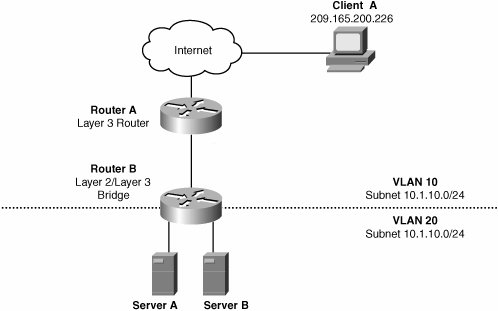Transparent Bridging
| Transparent bridging is similar to Layer 2 frame switching but is performed on Layer 3 routers to bridge between different VLANs that are on the same IP subnet. Bridging is useful for migration from one VLAN number to a new VLAN number, while keeping the same IP subnet. For example, if you require changing the number of a VLAN in your network, first configure your router to bridge between the old and new VLANs. Then create a new VLAN and reassign switch ports to the new VLAN one port at a time. Your router will bridge between the existing VLAN and new VLAN during the migration period. Figure 3-12 illustrates how bridging is performed by Cisco IOS routers in a simple transparent bridging configuration. Figure 3-12. Transparent Bridging In Figure 3-12, for the client to access Server A or B on VLAN 20, Router A first routes the packets to Router B. Router B then bridges packets between VLAN 10 and VLAN 20 at Layer 3 to the individual servers. For the servers to access one another, packets are switched at Layer 2 within VLAN 20 on Router B. Note Server load balancing (SLB) devices bridge between client-facing VLANs and server farm VLANS in the same way as Router B bridges in Figure 3-12. More information on bridging will be discussed in Chapter 10. Like most of the examples throughout this book, the servers in Figure 3-12 are assigned private addresses for illustration purposes only. In your network, publicly addressed servers may be beneficial. In order for the privately addressed servers in Figure 3-12 to communicate with the publicly addressed client at Layer 3, Network Address Translation (NAT) is required. |
EAN: 2147483647
Pages: 178
